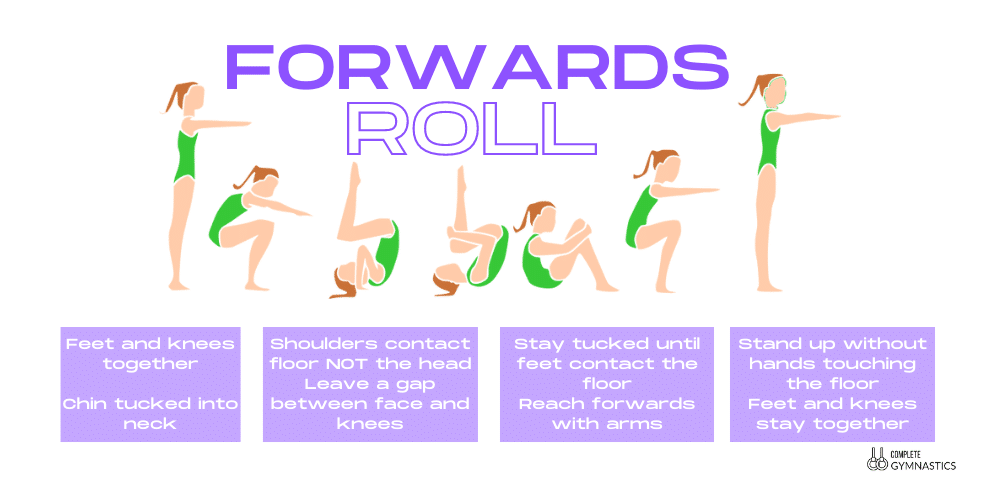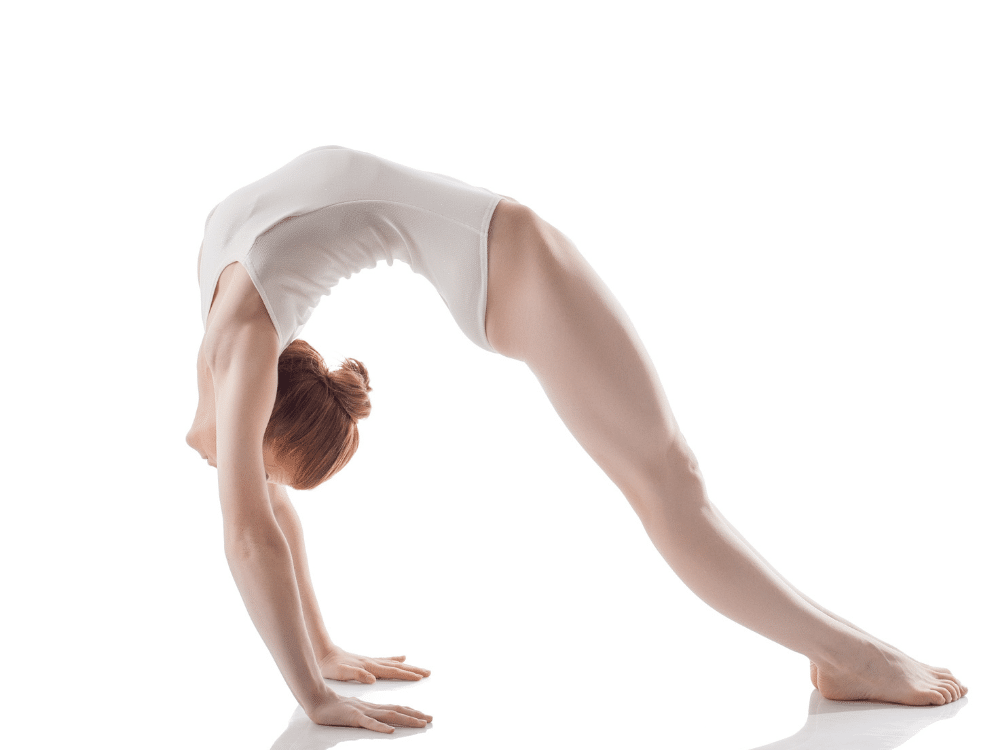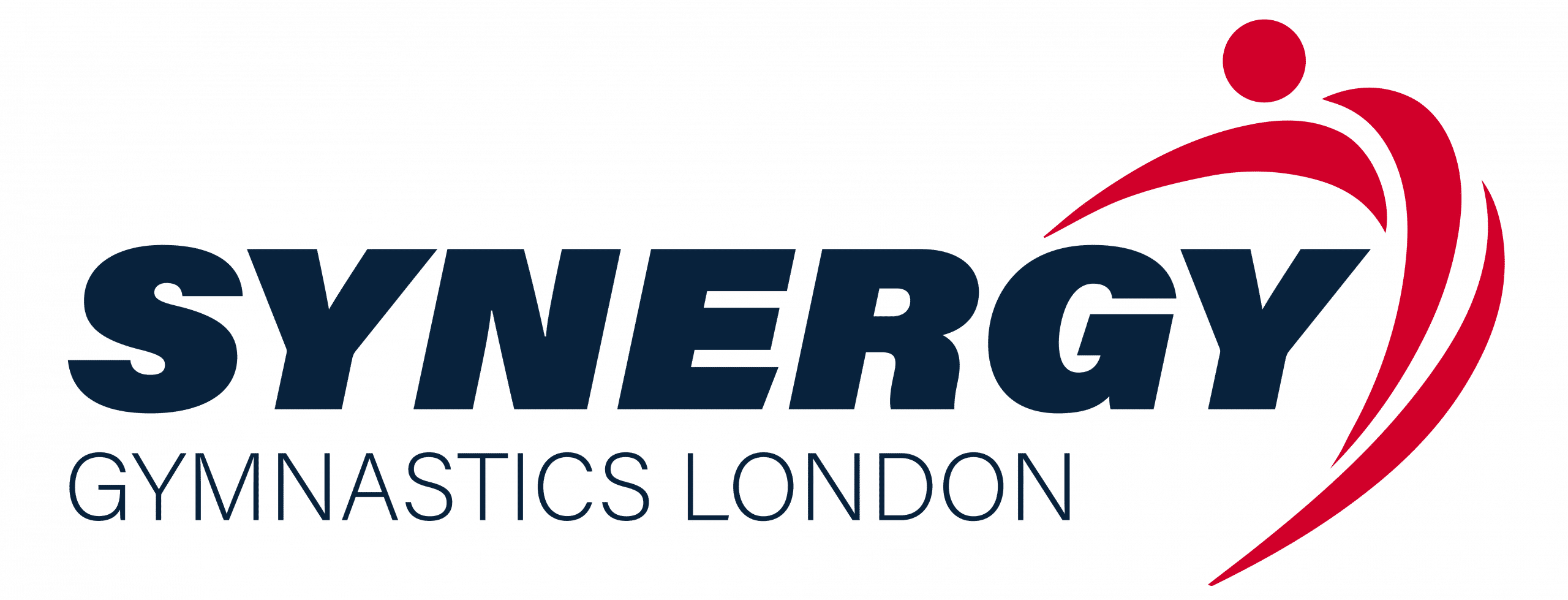
In this article, we guide you through dozens of gymnastics moves on floor that all gymnasts should aim to master. This list is based on the requirements for Artistic gymnasts but many of the skills are shared in different disciplines such as Tumbling and Acrobatics.
Disclaimer: Gymnastics carries an inherent level of risk. Information contained in this article does not replace the need for professional coaching in a recognized gymnastics facility.
Basic Body Shapes
Understanding basic body shaping is key to performing any of the floor skills listed in this guide. Mastering these basic shapes with good posture and body tension will make it a lot easier to learn more advanced skills in the future.
- Tuck
- Pike
- Straddle
- Stretched (standing)
- Star
- Front Support
- Back Support
- Hollow Dish
- Arch
Rolling
- Forwards Roll
- Backwards Roll
- Hollow Dish to Arch (Log Roll)
- Handstand Forward Roll
- Dive Forwards Roll
- Back Extension Roll
Basic Forwards and Backwards Rolls can be performed using various body shapes. Tucked is the easiest because round things always roll more easily than longer or straighter shapes. Rolls can also finish in star, piked or straddled shapes and even in a support shape. Back Extension Rolls require a lot of strength as they pass through the Handstand position.

Acro Moves
- Handstand
- Cartwheel
- Round off
- Front Walkover
- Back Walkover
- Front Handspring
- Back Handspring
- Aerial (Free) Cartwheel
These basic Acro moves are often linked together to make longer passes which also include somersaults. There are dozens of variations (too many to fit into this article) but to give you a basic example, a Handstand can also have a pirouette, hop or walk. Likewise, a Cartwheel could be performed with only one hand.
Somersaults
- Front Somi
- Back Somi
- Whip Back
- Twisting Somersaults
Somersaults (or somi for short) can be performed in tucked, piked or layout (straight) positions. Tucked is easiest and layout is usually the hardest for most gymnasts. Pucked somersaults are a very open tucked shape usually used as a progression to learning layout but are not recognized as a skill in competitions.
Twisting somersaults are performed in the layout position and can be added in halves. For example Back Layout with 1 and a half twists.
Advanced gymnasts can perform multiple somersaults combined with twists.
Balances
- Single Leg Balance
- Arabesque
- Y-Scale
- Headstand
- V-Sit
- Bridge
A good balance is held for around 5 seconds with good posture and minimum wobble. How you get into the balance and finish the balance is also important.

Jumps
- Straight Jump
- Tuck Jump
- Star Jump
- Straddle Jump
- Pike Jump
- Wolf Jump
- Split Jump
Turns can be added to most jumps in half-turn increments. For example, a Tuck Jump can be performed with a half-turn or full-turn. A straight body shape is the easiest to turn in.
Leaps
- Split Leap
- Cat Leap
- Ring Leap
- Switch Leg Leap
- Sissone
Jumps and Leaps are commonly found in Women’s Floor routines and are also transferred onto Balance Beam Routines.
Gymnastics Moves on Floor – Men’s Artistic
Whilst many skills are performed by both genders, some skills are only traditionally found in the Men’s program.
- Planche
- Flairs
- Manna
Basic Tumbling Passes
Artistic gymnasts perform routines on a sprung floor and are expected to include dynamic tumbling passes which demonstrate speed, height and power. These are a few basic tumbling passes often used in the USAG Women’s Development Program Levels.
- Round off – Back Handspring – Back Salto
- Front somi – Round Off – Back Handspring
- Front Handspring – Front Somi
Conclusion
Gymnastics moves on floor take time to master. Focus on the basic shapes first before progressing on to harder skills like somersaults and flips. The safest way to learn is always in a recognized gymnastics club with professional coaching.
Sign up for a free trial session at Synergy and we can help you master these gymnastics moves on floor!
FAQs
What is a floor skill in gymnastics?
A floor skill in gymnastics is a skill that can be performed without apparatus such as a roll, jump, leap or flexibility skill. More advanced floor skills include a Handstand, Cartwheel, Flips and Somersaults.
What is the hardest gymnastics trick on the floor?
In Women’s gymnastics, the hardest recognized skill is the Triple Twisting Double somersault first performed by Simone Biles. As such the move is named the Biles II. In Men’s gymnastics, triple somersaults are occasionally performed but they are rare due to the relatively small space of a floor area.
What is a floor routine?
A floor routine is made up of individual floor skills and linked together with choreography and dance. Beginner routines will include rolls, cartwheels or handstands whereas more advanced routines include back handsprings, somersaults and aerials.
How do I get stronger in gymnastics?
To get stronger in gymnastics you have to focus on regular conditioning exercises. Gymnasts often use body weight exercises like leg lifts, pull-ups and press-ups. There are dozens of common strength exercises but the key is to work on them consistently.
- How To Get Over a Mental Block In Gymnastics: A Complete Guide
 Gymnastics is a sport that requires not only physical strength and skill but also mental strength. When a gymnast feels like they cannot attempt… Read more: How To Get Over a Mental Block In Gymnastics: A Complete Guide
Gymnastics is a sport that requires not only physical strength and skill but also mental strength. When a gymnast feels like they cannot attempt… Read more: How To Get Over a Mental Block In Gymnastics: A Complete Guide - Find The Best Leotard For Girls (Guide)
 Finding an ideal leotard for girls isn’t just about picking a dazzling design that sparkles (although it does help!). The leotard has to fit… Read more: Find The Best Leotard For Girls (Guide)
Finding an ideal leotard for girls isn’t just about picking a dazzling design that sparkles (although it does help!). The leotard has to fit… Read more: Find The Best Leotard For Girls (Guide) - The Best Gymnastics Shorts (Our Top Picks)
 The best gymnastics shorts are designed to be worn over the top of a leotard providing additional coverage around the upper legs, whilst allowing… Read more: The Best Gymnastics Shorts (Our Top Picks)
The best gymnastics shorts are designed to be worn over the top of a leotard providing additional coverage around the upper legs, whilst allowing… Read more: The Best Gymnastics Shorts (Our Top Picks) - Decathlon Leotards – Are They Any Good?
 If you’re in the market for a new leotard, you may be wondering if Decathlon leotards are any good considering the low cost of… Read more: Decathlon Leotards – Are They Any Good?
If you’re in the market for a new leotard, you may be wondering if Decathlon leotards are any good considering the low cost of… Read more: Decathlon Leotards – Are They Any Good? - A Complete Guide to Gymnastics Hand Rips
 Are you tired of dealing with painful gymnastics rips on your hands from training? Look no further – this article offers a comprehensive approach… Read more: A Complete Guide to Gymnastics Hand Rips
Are you tired of dealing with painful gymnastics rips on your hands from training? Look no further – this article offers a comprehensive approach… Read more: A Complete Guide to Gymnastics Hand Rips - Is Gymnastics Dangerous? (Facts and Comparisons)
 Gymnastics is acknowledged as a highly technical and physically demanding sport. It inherently carries a risk of injury, which is why most coaches and… Read more: Is Gymnastics Dangerous? (Facts and Comparisons)
Gymnastics is acknowledged as a highly technical and physically demanding sport. It inherently carries a risk of injury, which is why most coaches and… Read more: Is Gymnastics Dangerous? (Facts and Comparisons)
